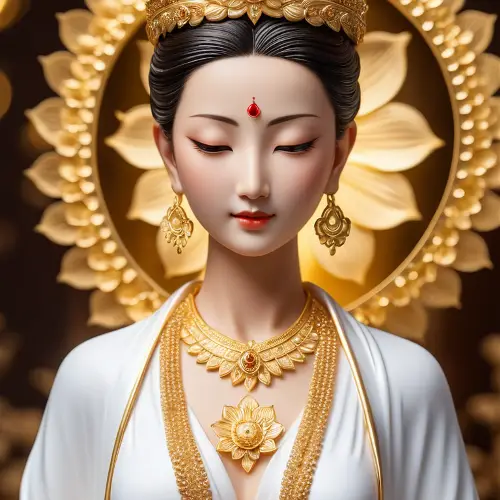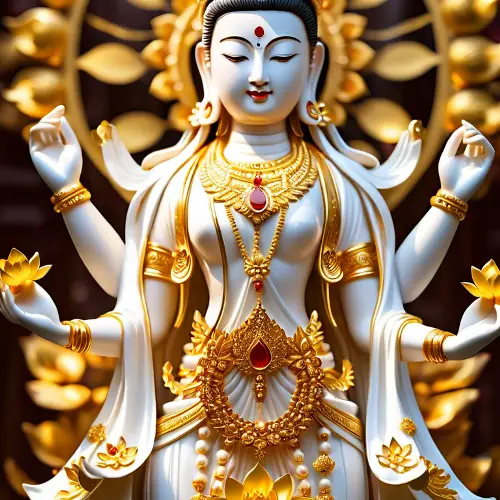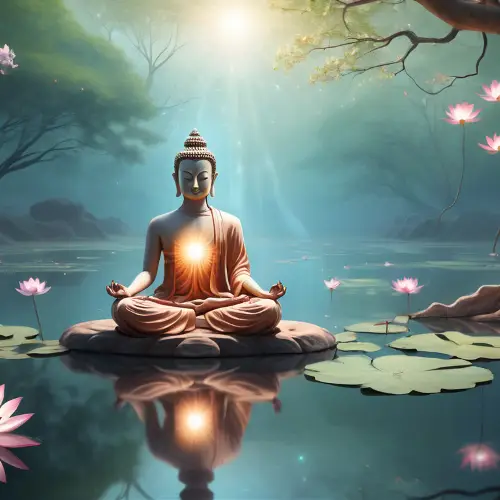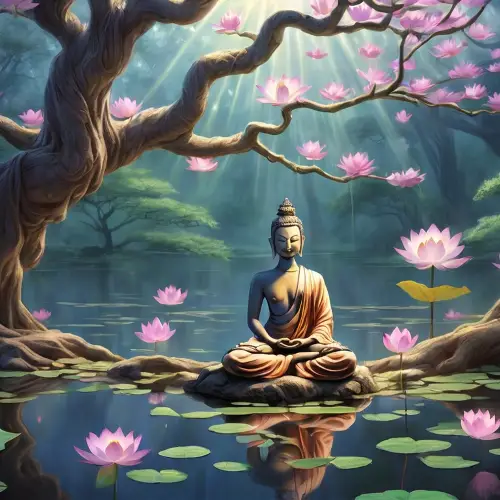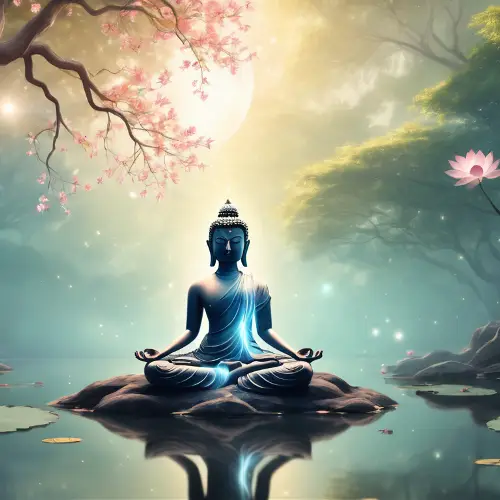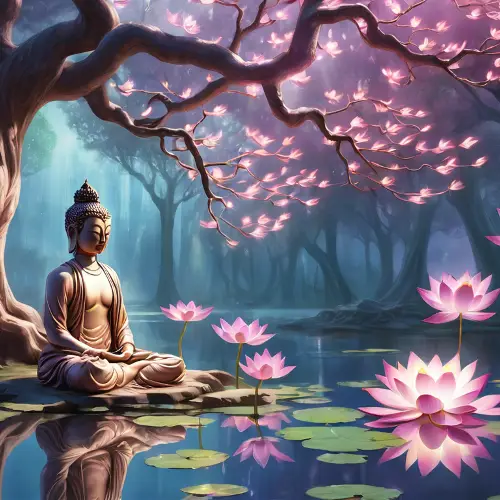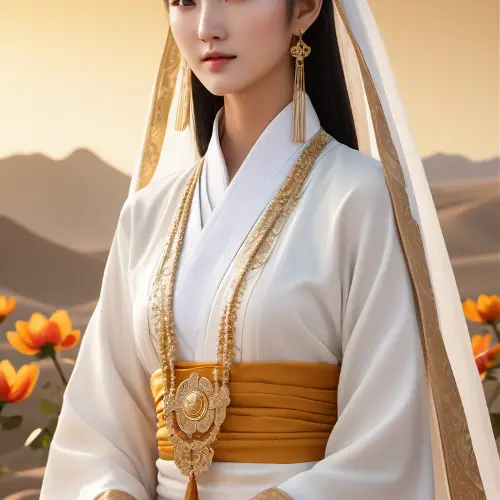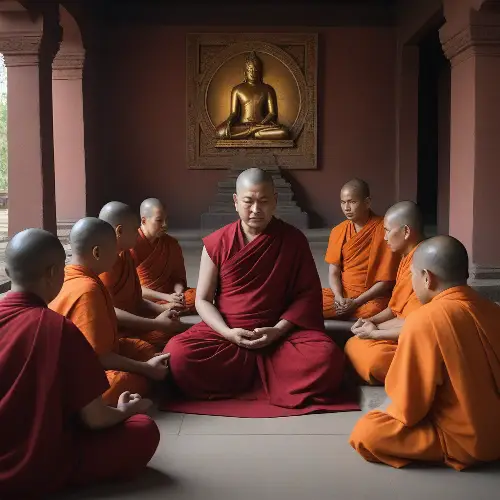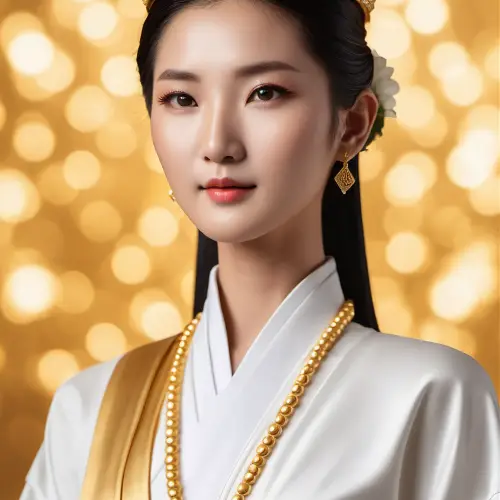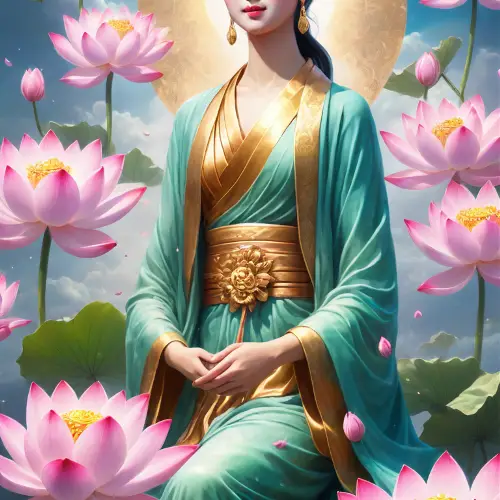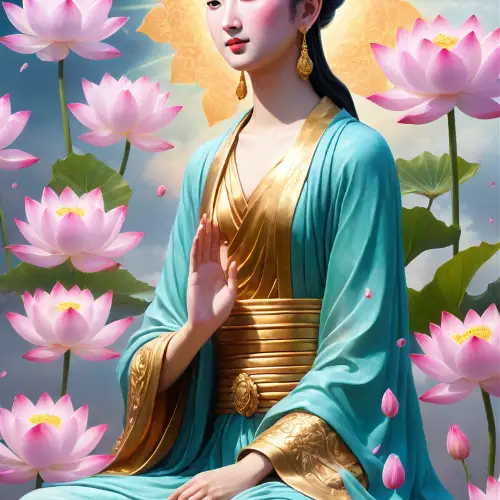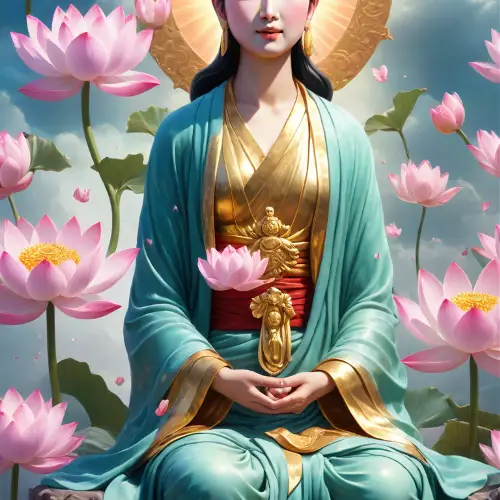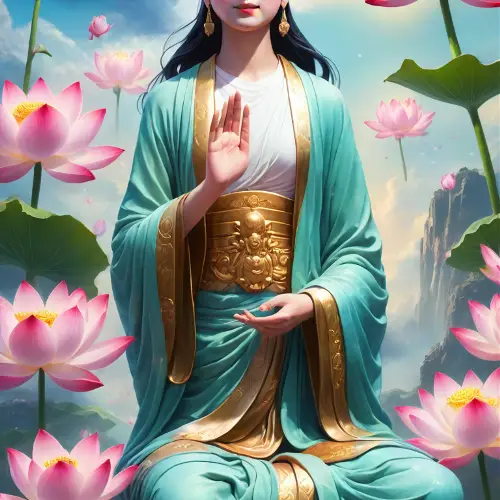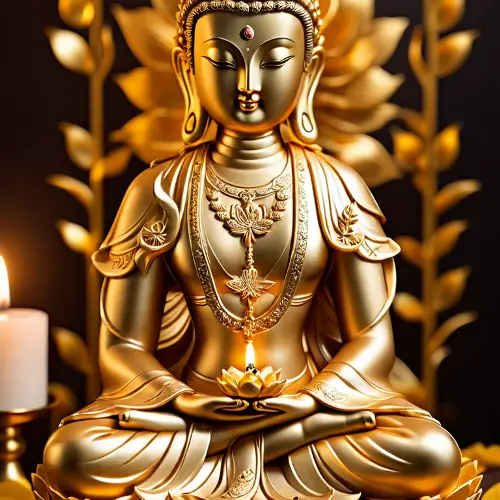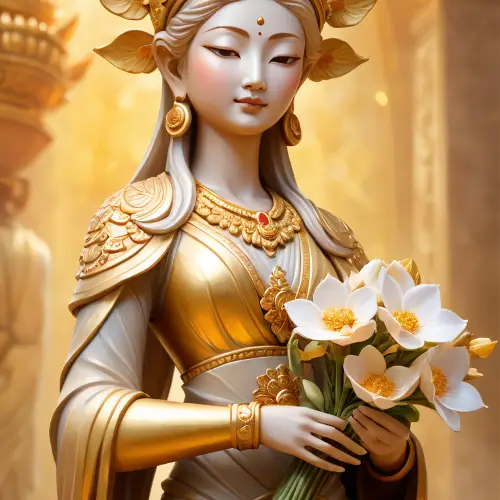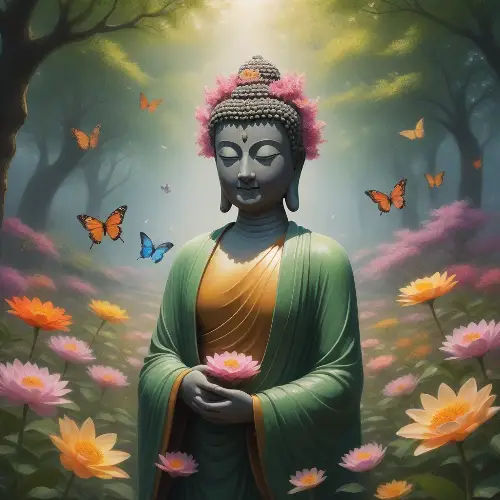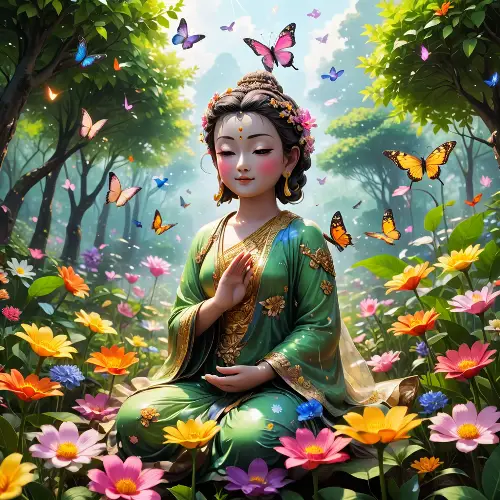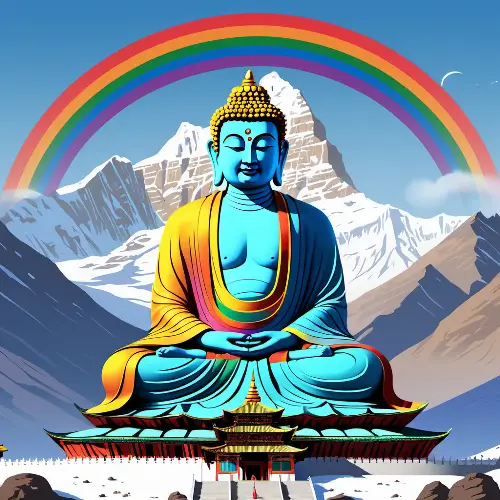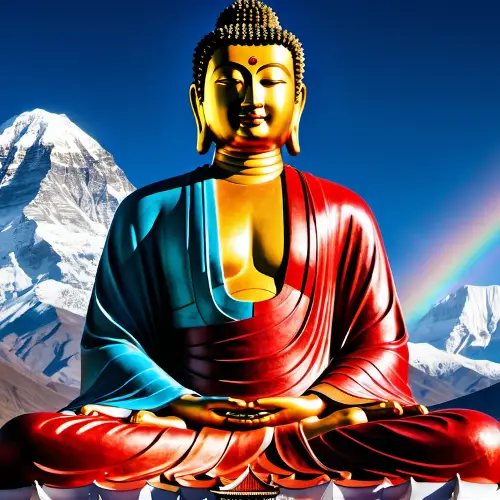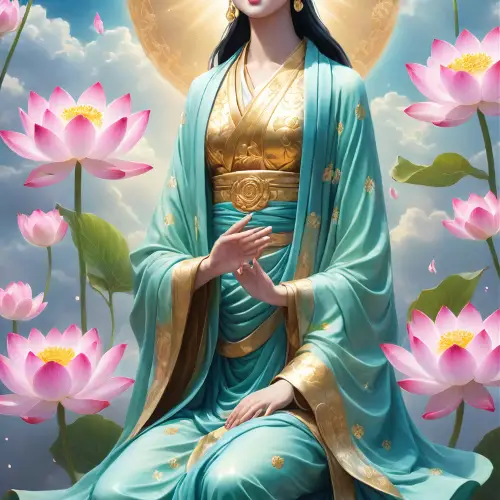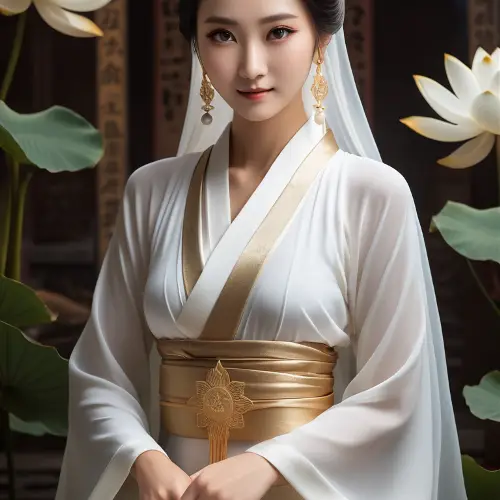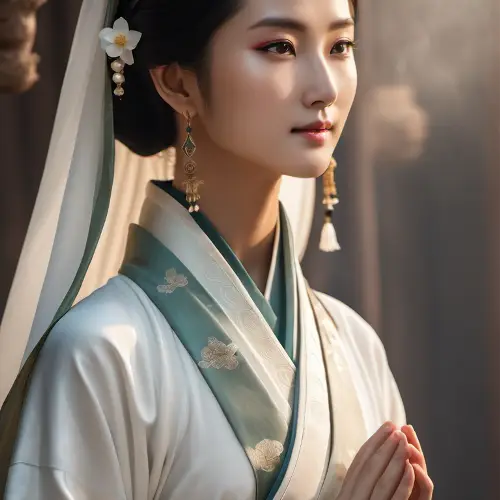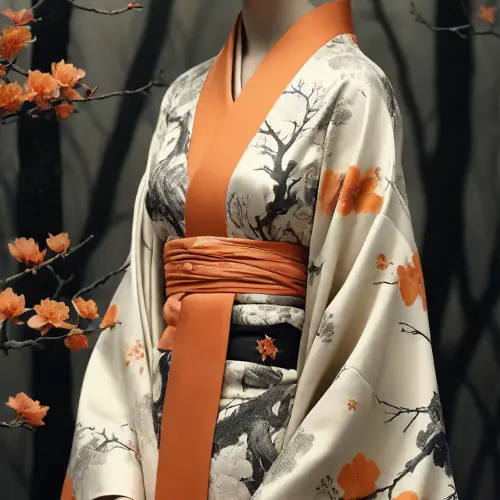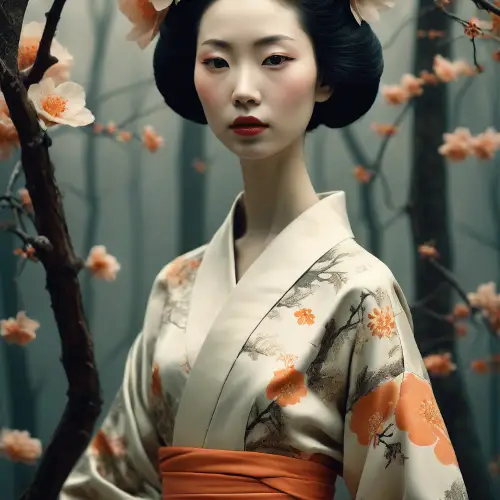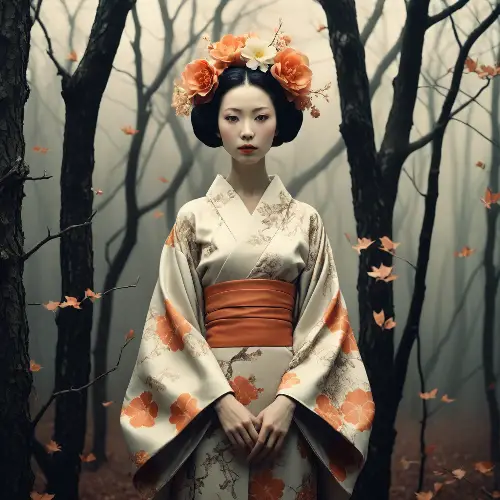A traditional Buddhist Bodhisattva, beautiful and gentle women, the King of the Earth Tibetan Bodhisattva, has a compassionate expression and wear gorgeous Buddhist costumes. Sitting by the lotus pot, explaining the Dharma to all livingbeings,
More Like This
A traditional Chinese Buddhist Bodhisattva, the King of the Earth Tibetan Bodhisattva, has a compassionate expression and wears gorgeous Buddhist costumes.
A statue of a Bodhisattva, ceramic, female, golden headdress, bust, golden clothing, golden lotus, Buddhism, hazy golden background, sacred light, compassionate, high-definition
Avalokitesvara Bodhisattva, wearing a crown, wreath, golden necklace, golden corsage, white dress, golden ribbon, circular light, lotus, lifelike, divine, sacred, Buddhist symbol
Visual representation of a serene moment with a Bodhisattva meditating under the branches of a tree, a peaceful pond nearby reflecting the beauty of lotus flowers, while a luminous aura surrounds the enlightened being
Visual representation of a serene moment with a Bodhisattva meditating under the branches of a tree, a peaceful pond nearby reflecting the beauty of lotus flowers, while a luminous aura surrounds the enlightened being
Sitting among the flowers doing,A golden sky background,Avalokitesvara Bodhisattva, wearing a crown, wreath, golden necklace, golden corsage, white dress, golden ribbon, circular light, lotus, lifelike, divine, sacred, Buddhist symbol,carved stone decorations dunhuang_style, dunhuang_cloths,beautiful eyes,radiance behind, (veil),front, text, halo,, (masterpiece:1. 0), (best quality:1. 3), (ultra highres:1. 2), (intricate details:1.3) ,1girl
a male appearance ksitigarbha bodhisattva sits cross-legged on a lotus flower,In the style of thangka, in style of holy, in style of Chinese traditional, --ar 9:16 --v 6.0 --s 250
a male appearance ksitigarbha bodhisattva sits cross-legged on a lotus flower,In the style of thangka, in style of holy, in style of Chinese traditional, --ar 9:16 --v 6.0 --s 250
Chinese ink painting style, a traditional Buddhist deity with a female image, a bodhisattva who governs the salvation of all beings, dressed in gorgeous robes and Buddhist attire, with a kind expression and a closed eye smile
Chinese ink painting style, traditional Buddhist deity, Ksitigarbha Bodhisattva, with a full body view, standing on a lotus, facing the camera with a compassionate and compassionate expression
A ceramic statue, female, with a golden headdress and clothes, holding flowers, Buddhism, Bodhisattva
In the hallowed hall of ancient Nalanda University, the air vibrates with wisdom, a scene not just to be witnessed but felt at the core of one's being. It's here that the great Buddhist philosopher and logically astute monk, Kumārila Buddhist Monk Dharmakirti, shares the profundity of his insights.Imagine the redstone architecture around him, aged and wise like the teachings it cradles. His skin is the color of the earth—a rich tan symbolizing a life rooted in the forests of meditation and thought. He sits, a stern embodiment of the discipline that threads through Buddhism, yet his eyes, deep pools of compassion, offer a glimpse into his enlightened soul. The walls behind Dharmakirti are adorned with ancient, delicately preserved Buddha murals. They echo the serenity and complex simplicity of the path he expounds. His red monastic robes are a bright flame in the quietude, a beacon for all seeking illumination. These robes ripple lightly with the wisdom that has been breathed into them through generations. His face is clean-shaven, as is the tradition, each smooth line telling a tale of renunciation and scholarly pursuits. In one hand, he holds a Buddhist mala, the beads sliding through his fingers with each silent mantra, an act of mindfulness amidst scholarly debate. His students, a circle of monks in training, sit wrapped in the same red as their teacher, a symbol of unity in their quest for understanding. They hang on his every word, minds and hearts open. The majestic pose Dharmakirti strikes is more than physical; it's a metaphor for the axis of wisdom around which they all revolve—a celestial dance of intellect and spirit. This cinematic snapshot from ancient times captures more than a moment; it encapsulates an era—an enduring testament to the pursuit of knowledge and spiritual enlightenment that once flourished within the nurturing stone embrace of Nalanda.
A golden sky background,Avalokitesvara Bodhisattva, wearing a crown, wreath, golden necklace, golden corsage, white dress, golden ribbon, circular light, lotus, lifelike, divine, sacred, Buddhist symbol
Bodhisattva, bust, light gold background, golden leaf lotus, candle, sitting in a cross
A ceramic statue, female, with a golden headdress and clothes, holding flowers, Buddhism, Bodhisattva, a hazy golden background, sacred light
A lovely beautiful girl in the middle of a flower garden, filled with every bit of her body and a colorful environment. There is a piece of green grass in the station, the surrounding area is full of colorful flowers, the wind is flowing, and the flowers are fragrant. After I was pregnant, I saw a gigantic lily of flowers and a powder-coloured yang, and the flowers were in full bloom in the spring wind. The light of the sun shines through the leaves of the tree, and the light and shadow appear on the body. A group of five-faced and six-colored butterflies fly in the distance, and the flowers in the sky grow together, making it a typical childhood dream. Minute rainbows and firebugs dance in the air, dots of light surround the space, and the Buddha's organized landscape appears in one layer of magical colors. The clothing that was worn on the body was very flattering, and the clothes were worn with a small wind, and the flowers and seas of the surrounding area were both profitable and profitable. A soft toy in the hands, a soft toy in her hands, a pure and pure curiosity in her eyes, a Buddha who is the guardian of the spirit in the middle of a flower garden, a suction suit that is suitable for all life, and a natural interaction with life in the form of one place.
Looking down from the perspective of space, the face of the huge translucent Buddha Shakyamuni is compassionate and solemn. Below is the snow-covered sacred mountain Kailash, and in the distance is Tibet's most famous palace, the Potala Palace, with a rainbow streaking across the sky. Giant thangka displayed halfway up the mountain with pilgrims, realistic photography style
Looking down from the perspective of space, the face of the huge translucent Buddha Shakyamuni is compassionate and solemn. Below is the snow-covered sacred mountain Kailash, and in the distance is Tibet's most famous palace, the Potala Palace, with a rainbow streaking across the sky. Giant thangka displayed halfway up the mountain with pilgrims, realistic photography style
Looking down from the perspective of space, the face of the huge translucent Buddha Shakyamuni is compassionate and solemn. Below is the snow-covered sacred mountain Kailash, and in the distance is Tibet's most famous palace, the Potala Palace, with a rainbow streaking across the sky. Giant thangka displayed halfway up the mountain with pilgrims, realistic photography style
An ancient Chinese woman with unusually beautiful and attractive features and a serious expression, dressed in the ornate clothes and headdress worn only by royalty, sits in front of a brocade-patterned fresco. Behind the chair stand two maids in ordinary clothes without headdresses , the two maids' clothes are of the same style --ar 3:4 --v 5.1
An ancient Chinese woman with unusually beautiful and attractive features and a serious expression, dressed in the ornate clothes and headdress worn only by royalty, sits in front of a brocade-patterned fresco. Behind the chair stand two maids in ordinary clothes without headdresses , the two maids' clothes are of the same style--ar 3:4 --v 6
An ancient Chinese woman with unusually beautiful and attractive features and a serious expression, dressed in the ornate clothes and headdress worn only by royalty, sits in front of a brocade-patterned fresco. Behind the chair stand two maids in ordinary clothes without headdresses , the two maids' clothes are of the same style--ar 3:4 --v 6
design concept: This series of ornaments aims to integrate the peace and wisdom of Buddhism into daily life. By placing these exquisite pieces in your work and living spaces. Product Series: Gautama Buddha Ornaments: Posture: Showing the quiet posture of Sakyamuni attaining enlightenment under the bodhi tree. Material: Bronze, stone carving or wood carving can be used to reflect the beauty of traditional craftsmanship. Features: Exquisite details, serene and solemn expression, reflecting deep introspection and enlightenment. Guanyin Bodhisattva ornaments: Posture: Show Guanyin Bodhisattva’s compassionate and peaceful standing or sitting posture. Material: white porcelain or jade to reflect its purity and compassion. Characteristics: Gentle face and smooth clothing lines, showing boundless compassion and calmness. Design elements: Shape: The shape should be simple and elegant, avoid overly complicated decoration, and reflect the tranquility and simplicity of Buddhism. Color: Use calm or natural colors, such as limestone gray, bronze green, jade white, etc. Decoration: You can add Buddhist elements to the base or background, such as lotus flowers and Dharma wheels, but the overall simplicity and harmony should be maintained. Functional Considerations: Size: Designed in various sizes to adapt to different space needs, from small tabletop ornaments to larger display items. Stability: Make sure the bottom of the ornament is stable Packaging: Exquisite packaging design not only protects the ornaments, but is also suitable as a gift.
ink painting style, rice paper,Guanyin Bodhisattva, ethereal, celestial aura, serene, lotus throne, flowing white robes, holding branch, compassion in eyes, tranquil smile, pearl of wisdom, surrounded by gentle light,cross-legged, setting in a sacred temple, calm water body, lotus flowers, incense smoke, ancient Buddhist symbols, carved stone decorations dunhuang_style, dunhuang_cloths,beautiful eyes,radiance behind, (veil),front, text, halo,, (masterpiece:1. 0), (best quality:1. 3), (ultra highres:1. 2), (intricate details:1.3) ,1girl
sage seated on a lotus flower in the middle of a serene pond, surrounded by lush greenery and vibrant lotus blossoms. The water reflects the clear blue sky, symbolizing the interconnectedness of mind and nature
sage seated on a lotus flower in the middle of a serene pond, surrounded by lush greenery and vibrant lotus blossoms. The water reflects the clear blue sky, symbolizing the interconnectedness of mind and nature
a meditating woman of 25 years old in a lotus position, radiating peace and harmony. Around her are symbols of mindfulness: reflections of nature, meditation symbols and a color spectrum that emphasizes the positive impact of the practice on the emotional state. The background is soft and diffused, creating a sense of calm and inner balance.
a meditating woman of 25 years old in a lotus position, radiating peace and harmony. Around her are symbols of mindfulness: reflections of nature, meditation symbols and a color spectrum that emphasizes the positive impact of the practice on the emotional state. The background is soft and diffused, creating a sense of calm and inner balance.
a meditating woman of 25 years old in a lotus position, radiating peace and harmony. Around her are symbols of mindfulness: reflections of nature, meditation symbols and a color spectrum that emphasizes the positive impact of the practice on the emotional state. The background is soft and diffused, creating a sense of calm and inner balance.
a meditating woman of 25 years old in a lotus position, radiating peace and harmony. Around her are symbols of mindfulness: reflections of nature, meditation symbols and a color spectrum that emphasizes the positive impact of the practice on the emotional state. The background is soft and diffused, creating a sense of calm and inner balance.
A beautiful long-haired woman sits cross-legged on the grass, wearing an exquisite Athena-style white long dress, surrounded by some white flowers, meditating. Her face is calm and gentle. The background color is bright purple, with soft, high-quality lighting, focusing on her entire body.
In a masterpiece orchestrated by the lens of Dmitry Kosovoy, we find a woman transformed into a living sculpture amidst a surreal forest of lifeless trees. This composition takes inspiration from the artistic style of Ray Caesar, blending the ethereal and the tangible in breathtaking harmony. The central figure, a woman of profound grace and mystique, dons an elaborate kimono that billows around her like the petals of a surreal flower. The kimono itself is a work of art, adorned with intricate patterns in contrasting shades of dark white and light orange. These colors create an otherworldly ambiance that defies conventional reality. As if in a reverie of juxtaposition, the forest surrounding her consists of dead trees, their twisted branches reaching out like skeletal fingers. These eerie remnants of nature form a compelling backdrop, serving as a stark contrast to the woman's vitality. The composition is further enriched by the presence of birds and flowers, mirroring the themes found in the works of Patricia Piccinini. These avian and floral elements lend an aura of life and renewal to the scene, suggesting that even in desolation, there is the potential for rebirth and transformation. The influence of Zen Buddhism is evident in the woman's serene expression and the tranquil energy that emanates from her. It's as though she has discovered a profound connection between her inner self and the world around her. The technical aspects of this photograph are as impressive as its artistic elements. High-resolution photography is a must, ensuring that every nuance, from the intricate details of the kimono to the fine texture of the dead trees, is captured with utmost clarity. To bring out the depth and dimensionality of the portrait, Dmitry Kosovoy employs the Rembrandt lighting technique. This technique bathes the subject's face in a soft, diffused light, accentuating the sculptural qualities of her visage and adding a touch of chiaroscuro drama to the scene. The backdrop is a seamless canvas, allowing the subject to take center stage without any distractions. This simplicity enhances the dreamlike quality of the photograph, emphasizing the woman's role as a living sculpture amidst a surreal and captivating landscape. The result is not just a photograph but a work of art that transcends the boundaries of reality, inviting viewers to contemplate the delicate interplay between life and death, art and nature, and the enduring beauty of the human spirit --ar 23:24 --
In a masterpiece orchestrated by the lens of Dmitry Kosovoy, we find a woman transformed into a living sculpture amidst a surreal forest of lifeless trees. This composition takes inspiration from the artistic style of Ray Caesar, blending the ethereal and the tangible in breathtaking harmony. The central figure, a woman of profound grace and mystique, dons an elaborate kimono that billows around her like the petals of a surreal flower. The kimono itself is a work of art, adorned with intricate patterns in contrasting shades of dark white and light orange. These colors create an otherworldly ambiance that defies conventional reality. As if in a reverie of juxtaposition, the forest surrounding her consists of dead trees, their twisted branches reaching out like skeletal fingers. These eerie remnants of nature form a compelling backdrop, serving as a stark contrast to the woman's vitality. The composition is further enriched by the presence of birds and flowers, mirroring the themes found in the works of Patricia Piccinini. These avian and floral elements lend an aura of life and renewal to the scene, suggesting that even in desolation, there is the potential for rebirth and transformation. The influence of Zen Buddhism is evident in the woman's serene expression and the tranquil energy that emanates from her. It's as though she has discovered a profound connection between her inner self and the world around her. The technical aspects of this photograph are as impressive as its artistic elements. High-resolution photography is a must, ensuring that every nuance, from the intricate details of the kimono to the fine texture of the dead trees, is captured with utmost clarity. To bring out the depth and dimensionality of the portrait, Dmitry Kosovoy employs the Rembrandt lighting technique. This technique bathes the subject's face in a soft, diffused light, accentuating the sculptural qualities of her visage and adding a touch of chiaroscuro drama to the scene. The backdrop is a seamless canvas, allowing the subject to take center stage without any distractions. This simplicity enhances the dreamlike quality of the photograph, emphasizing the woman's role as a living sculpture amidst a surreal and captivating landscape. The result is not just a photograph but a work of art that transcends the boundaries of reality, inviting viewers to contemplate the delicate interplay between life and death, art and nature, and the enduring beauty of the human spirit --ar 23:24 --
In a masterpiece orchestrated by the lens of Dmitry Kosovoy, we find a woman transformed into a living sculpture amidst a surreal forest of lifeless trees. This composition takes inspiration from the artistic style of Ray Caesar, blending the ethereal and the tangible in breathtaking harmony. The central figure, a woman of profound grace and mystique, dons an elaborate kimono that billows around her like the petals of a surreal flower. The kimono itself is a work of art, adorned with intricate patterns in contrasting shades of dark white and light orange. These colors create an otherworldly ambiance that defies conventional reality. As if in a reverie of juxtaposition, the forest surrounding her consists of dead trees, their twisted branches reaching out like skeletal fingers. These eerie remnants of nature form a compelling backdrop, serving as a stark contrast to the woman's vitality. The composition is further enriched by the presence of birds and flowers, mirroring the themes found in the works of Patricia Piccinini. These avian and floral elements lend an aura of life and renewal to the scene, suggesting that even in desolation, there is the potential for rebirth and transformation. The influence of Zen Buddhism is evident in the woman's serene expression and the tranquil energy that emanates from her. It's as though she has discovered a profound connection between her inner self and the world around her. The technical aspects of this photograph are as impressive as its artistic elements. High-resolution photography is a must, ensuring that every nuance, from the intricate details of the kimono to the fine texture of the dead trees, is captured with utmost clarity. To bring out the depth and dimensionality of the portrait, Dmitry Kosovoy employs the Rembrandt lighting technique. This technique bathes the subject's face in a soft, diffused light, accentuating the sculptural qualities of her visage and adding a touch of chiaroscuro drama to the scene. The backdrop is a seamless canvas, allowing the subject to take center stage without any distractions. This simplicity enhances the dreamlike quality of the photograph, emphasizing the woman's role as a living sculpture amidst a surreal and captivating landscape. The result is not just a photograph but a work of art that transcends the boundaries of reality, inviting viewers to contemplate the delicate interplay between life and death, art and nature, and the enduring beauty of the human spirit --ar 23:24 --






